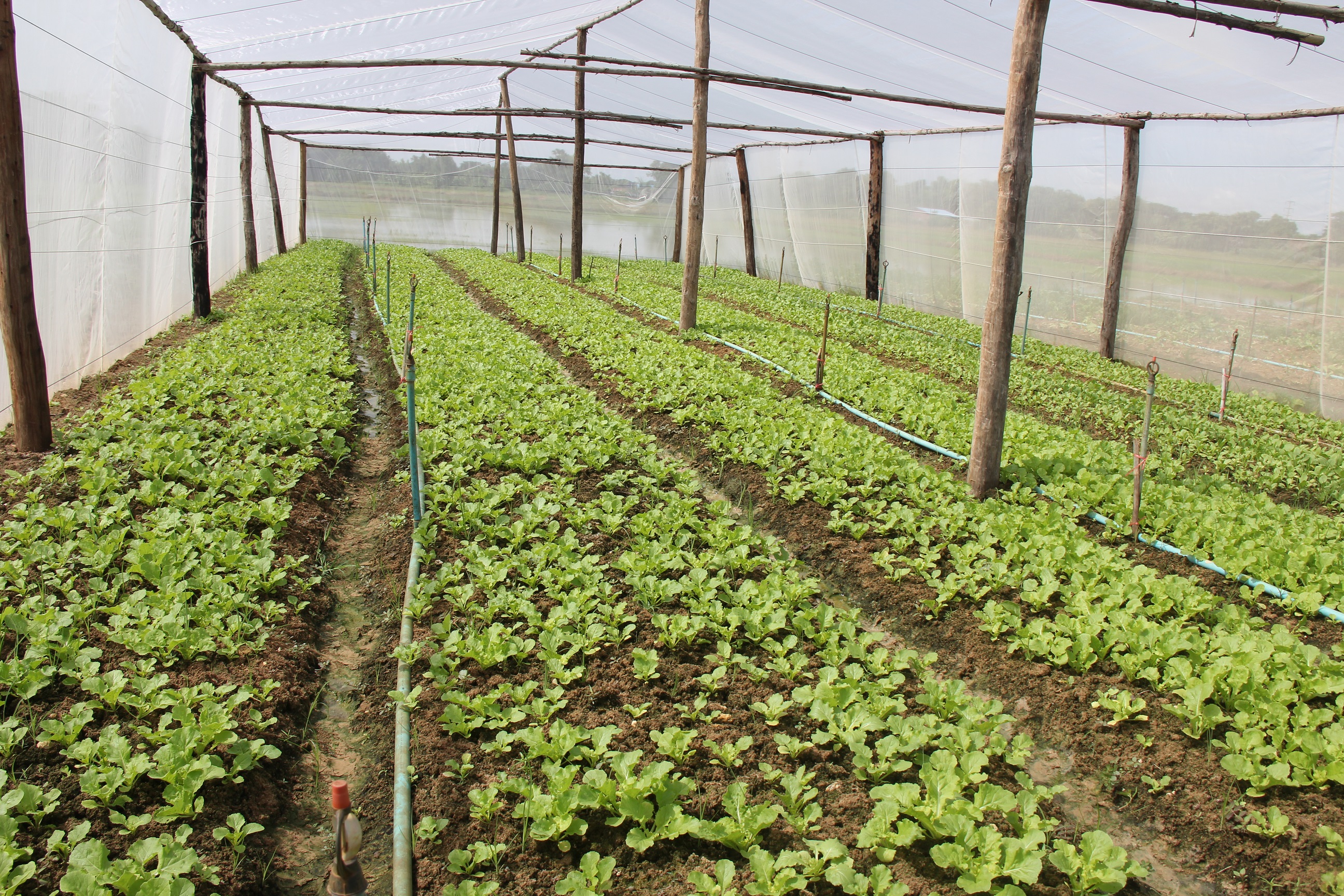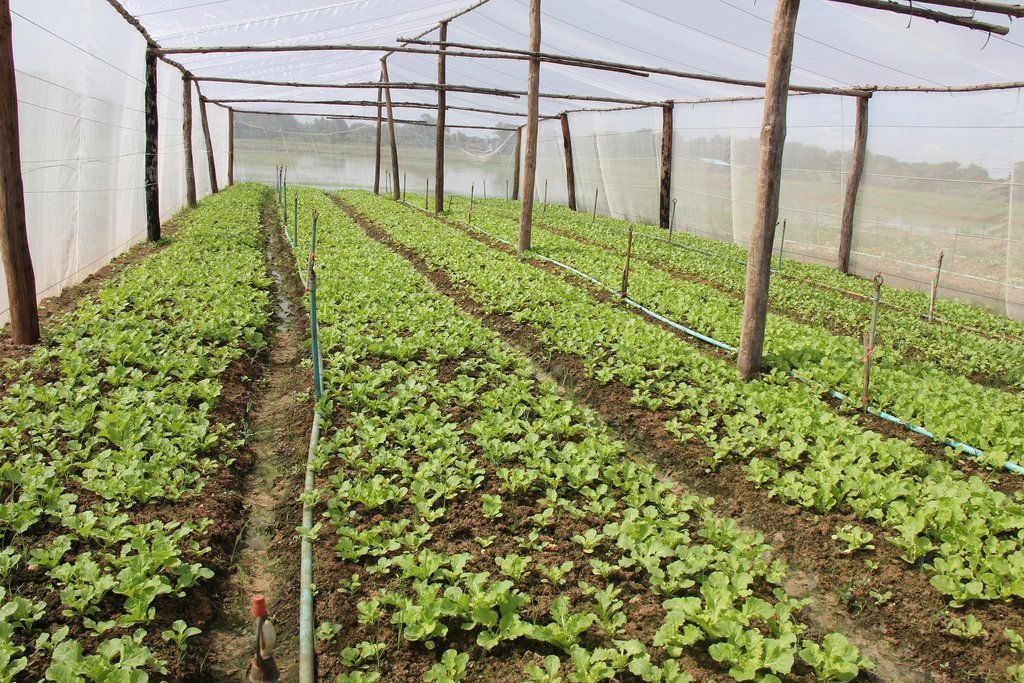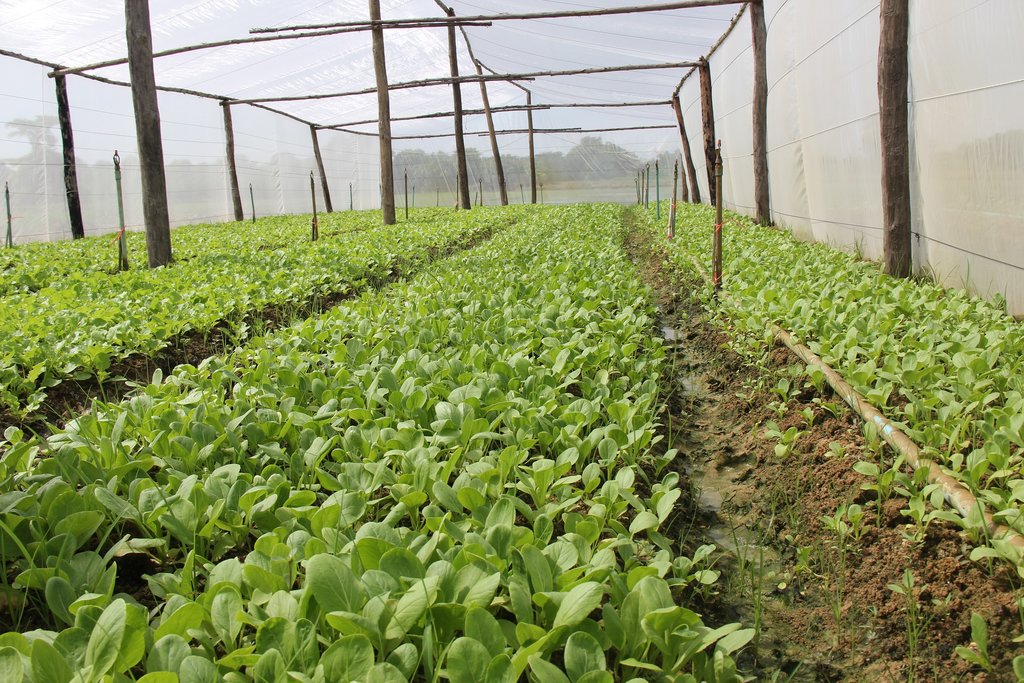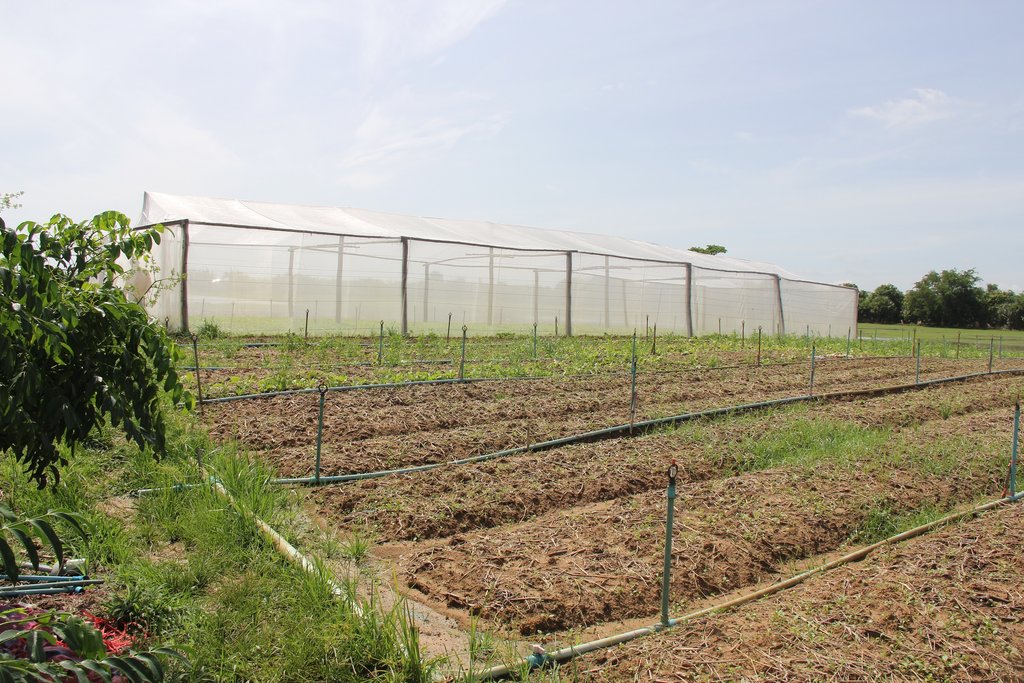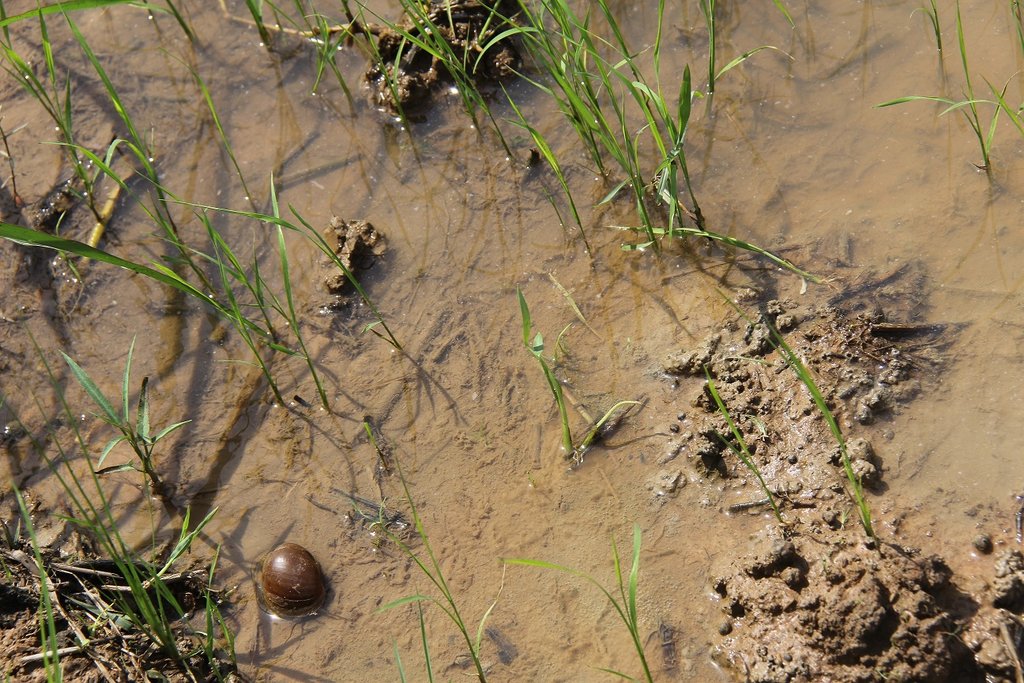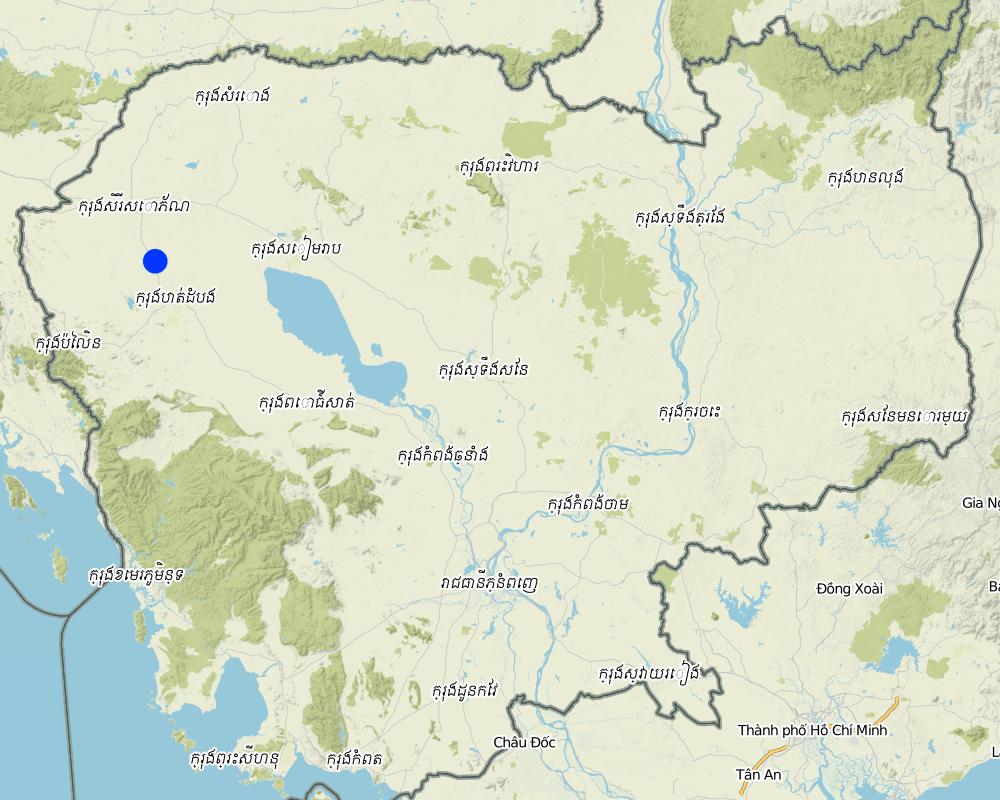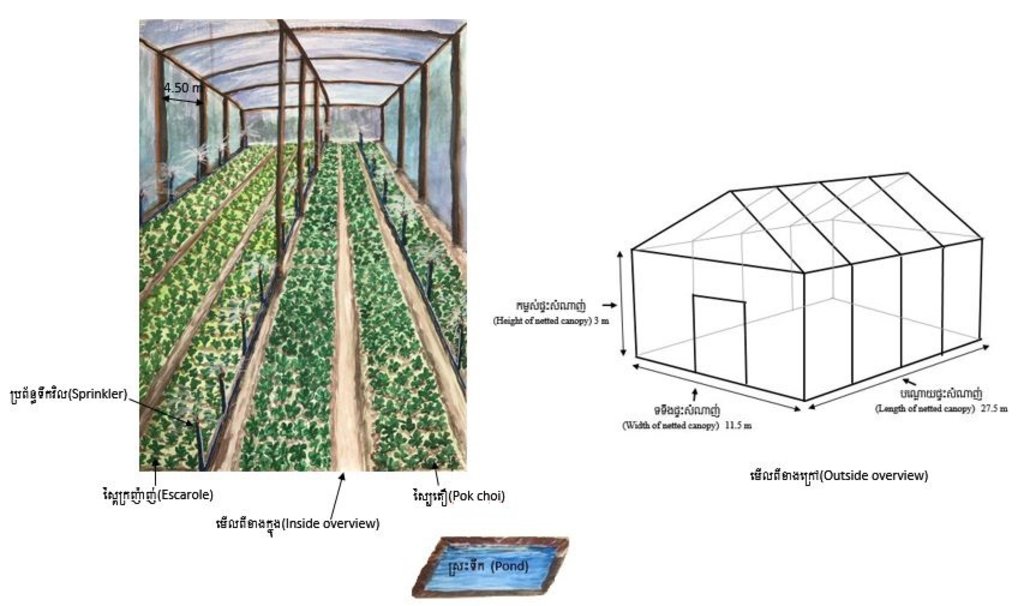Growing vegetables in a nethouse to ward off insects [Cambodia]
- Creation:
- Update:
- Compiler: Nary Lay
- Editors: Navin Chea, Sophea Tim
- Reviewers: Cornelia Hett, Nicole Harari, SO Than, Ursula Gaemperli
Nethouse
technologies_3138 - Cambodia
View sections
Expand all Collapse all1. General information
1.2 Contact details of resource persons and institutions involved in the assessment and documentation of the Technology
Key resource person(s)
Agricultural Extension Official at Agricultural Office of Thma Koul:
Seiv Daraposa
(+855) 12 501 462
NA
Agricultural Office of Thma Koul
Kaksekam village, Ta Pung commune, Thma Koul district, Battambang province.
Cambodia
Chief of Agricultural Office of Sankae:
Agronomy Official at Agricultural Office of Bavel:
Mout Larm
(+855) 89 375 5006
NA
Agricultural Office of Bavel
Tumnob Tuek village, Bavel commune, Bavel district, Battambang province
Cambodia
land user:
Seng Sarun
(+855) 85 482 277
NA
Farmer
Ta Sei village, Ta Meun commune, Thma Koul district, Battambang province
Cambodia
Staff of Project Safe Vegetable Value Chain in Cambodia :
Nin Davuth
(+855) 98 864 393
davuthnin@yahoo.com
Division of Research and Extension, Royal University of Agriculture.
Ruessei village, Preaek Preah Sdach commune, Battambang district, Battambang province
Cambodia
Team Leader of Group Safe Vegetable at Ta Sei village:
Nob Nun
(+855) 89 661 099
NA
Division of Research and Extension, Royal University of Agriculture.
Ta Sei village, Ta Meun commune, Tma Koul district, Battambang provice
Cambodia
Name of project which facilitated the documentation/ evaluation of the Technology (if relevant)
Scaling-up SLM practices by smallholder farmers (IFAD)Name of the institution(s) which facilitated the documentation/ evaluation of the Technology (if relevant)
Royal University of Agriculture (RUA) - Cambodia1.3 Conditions regarding the use of data documented through WOCAT
When were the data compiled (in the field)?
03/07/2017
The compiler and key resource person(s) accept the conditions regarding the use of data documented through WOCAT:
Yes
1.4 Declaration on sustainability of the described Technology
Is the Technology described here problematic with regard to land degradation, so that it cannot be declared a sustainable land management technology?
No
2. Description of the SLM Technology
2.1 Short description of the Technology
Definition of the Technology:
A nethouse is a structure that is enclosed by a nylon net (like mosquito nets) which protects vegetables from insects. Additionally, it prevents the vegetables from being damaged by rainfall wind and sunlight.
2.2 Detailed description of the Technology
Description:
Currently one of the major challenges farmer face when growing vegetables is the damage caused by insects. Moreover, climate change creates obstacles when cultivating crops such as irregular rainfall, strong winds, and a rise in temperature. In order to address these issues the farmers trialed the growing of vegetables under a nethouse. Nethouses also enable crop growing throughout the whole year.
The main purpose of building a nethouse is to ward off insects without having to apply pesticides. A nethouse is highly effective in damage reduction caused by insects on crop from 80% to 100% (Stilers, 2011). Also farmers noticed that there's no significant insect infestation when using this technology. The netted roof helps to protect vegetables from direct rainfall onto them as this can damage plants or splashes soil on plant's leaves. As well it is slowing down the speed of rainfall and split it into small droplets, which is important to improve the cultivation of vegetables during rainy season, (usually farmer can grow vegetables only during dry season).
Nethouses come in a range of different size and height, and construction materials also differ depending on the available resources. Before setting up a nethouse, farmer will firstly have to prepare the terrain and then mark out the points where posts will be installed (generally it is rectangular in shape) and dig holes measuring 0.40 meters x 0.40 meters with a depth of 1 meter at all of the marked out point. After post have been inserted into these holes they should be filled with concrete to a height of 60 cm so as to secure post (the length of side post are 3 meters and the middle post are 4 meters). After frame completion, nylon ropes are extended. They act as frames to support the net and then lastly, the net is rolled over the frame to cover the entire nethouse (the sides of net should be buried in ground at a depth of 25 cm). There are two common types of nethouse roofs, those being either a gable roof or a curved (gambrel) roof, which is better than a flat roof that risks breaking down when water accumulates on it during heavy rainfalls.
Farmers generally use the same cultivation techniques as other farmers. The differences lie in the nethouse, in nearly no use of chemical fertilizers and in complete elimination of pesticide. The interviewed farmer established a nethouse measuring 316.25 square meters at Tasei village, Tameun commune (Thmakoul district). The land selected by the farmer for such nethouse vegetable growing was previously a rice field. He considered that rice can only be grown once a year, whereas vegetables can be grown throughout the year. Thus, it is possible to generate more income. They decided to dig a large pond (35meter x 35meter) for water storage connected to the irrigation system, which disburden him from watering during dry season. Initially, the excavated soil was less fertile, but the farmer used compost for one year, after which it was possible to improve the soil quality. The farmer makes dry and liquid compost by himself and also uses organic fertilizer which is purchased externally. The liquid compost is made up of sugar palm 1 kg, pineapple 5 kg and coconut juice 2 liters. This practice adds nutrients to soil and promotes a lot of living organisms that make crops flourish.
Comparing the construction costs and time it takes to make a profit from sale of vegetables farmers have to have at least three harvests before they can cover the cost of the nethouse or to achieve the profit. The nethouse can be used for a period of 10 to 13 years, and it is only necessary to change the nylon net once it is ripped. The actual gross income from pok choi and escarole is 1,590,000 riels for 530 kilograms.
If he continued to produce rice on this land, this would generate 100kg of rice sold at about 800 riels per kg and so, he would gain 80,000 riels per year. However, as the farmer applies this technology he can grow vegetable several times per year (6-7 times) with an average yield of 530 kg per harvest that amounts to 3,180 kg per year. If one kilogram of vegetables is worth 3000 riel he is able to generate an income of around 9,540,000 riel, which is more than hundredfold that of rice. Additionally, he is able to produce safe vegetables, contributes to the reduction in environmental pollution and the technology is adapted to climate change.
2.3 Photos of the Technology
2.4 Videos of the Technology
Comments, short description:
NA
Name of videographer:
NA
2.5 Country/ region/ locations where the Technology has been applied and which are covered by this assessment
Country:
Cambodia
Region/ State/ Province:
Ta Sei village, Ta Meun commune, Thmakoul district, Battambang province.
Further specification of location:
The farm behind the village
Map
×2.6 Date of implementation
Indicate year of implementation:
2017
2.7 Introduction of the Technology
Specify how the Technology was introduced:
- through projects/ external interventions
Comments (type of project, etc.):
The Project Safe Vegetable Value Chain in Cambodia, implemented by Division of Research and Extension of Royal University of Agriculture and funded by USAID.
3. Classification of the SLM Technology
3.1 Main purpose(s) of the Technology
- improve production
- reduce, prevent, restore land degradation
- protect a watershed/ downstream areas – in combination with other Technologies
- preserve/ improve biodiversity
- adapt to climate change/ extremes and its impacts
- create beneficial economic impact
- improve consumers health
3.2 Current land use type(s) where the Technology is applied

Cropland
- Annual cropping
- Short-term crop
Main crops (cash and food crops):
Pok choi, escarole, choy sum, cabbage in rotation during one year
If land use has changed due to the implementation of the Technology, indicate land use before implementation of the Technology:
It used to be the paddy field before but it just changed to vegetable growing last year (2017).
3.3 Further information about land use
Water supply for the land on which the Technology is applied:
- mixed rainfed-irrigated
Comments:
There is pond for irrigation during drought and dry season.
Number of growing seasons per year:
- 3
Specify:
Vegetable can be grown from 6 to 7 times per year
Livestock density (if relevant):
N/A
3.4 SLM group to which the Technology belongs
- rotational systems (crop rotation, fallows, shifting cultivation)
- improved ground/ vegetation cover
- integrated pest and disease management (incl. organic agriculture)
3.5 Spread of the Technology
Specify the spread of the Technology:
- evenly spread over an area
If the Technology is evenly spread over an area, indicate approximate area covered:
- < 0.1 km2 (10 ha)
3.6 SLM measures comprising the Technology

agronomic measures
- A1: Vegetation/ soil cover
- A2: Organic matter/ soil fertility

structural measures
- S7: Water harvesting/ supply/ irrigation equipment
- S9: Shelters for plants and animals
3.7 Main types of land degradation addressed by the Technology

soil erosion by water
- Wt: loss of topsoil/ surface erosion

chemical soil deterioration
- Cp: soil pollution

biological degradation
- Bl: loss of soil life
- Bp: increase of pests/ diseases, loss of predators

water degradation
- Ha: aridification
3.8 Prevention, reduction, or restoration of land degradation
Specify the goal of the Technology with regard to land degradation:
- prevent land degradation
4. Technical specifications, implementation activities, inputs, and costs
4.1 Technical drawing of the Technology
4.2 Technical specifications/ explanations of technical drawing
The nethouse is 27.50 meters x 11.50 meters, with 3 meters high. It uses 18 wooden pillars with a space of 4.50 meters from to another. Inside the nethouse, there are 6 rows of vegetable and each row has 9 sprinkler heads for the irrigation. Actually, the farmer planed 2 types of crop - pok choi and escarole. The ways between the vegetable rows are about 45 centimeters in width.
4.3 General information regarding the calculation of inputs and costs
Specify how costs and inputs were calculated:
- per Technology area
Indicate size and area unit:
316.25 square meters
other/ national currency (specify):
KHR
Indicate exchange rate from USD to local currency (if relevant): 1 USD =:
4000.0
Indicate average wage cost of hired labour per day:
28000
4.4 Establishment activities
| Activity | Type of measure | Timing | |
|---|---|---|---|
| 1. | Prepare the land | Agronomic | June |
| 2. | Make the pillars for the nethouse | Structural | June |
| 3. | Make the roof and the surrounding with the nylon netting | Structural | June |
| 4. | Plow the land again | Agronomic | June |
| 5. | Make the row and prepare sprinkler system | Structural | June |
| 6. | Irrigation and planting | Agronomic | July |
4.5 Costs and inputs needed for establishment
| Specify input | Unit | Quantity | Costs per Unit | Total costs per input | % of costs borne by land users | |
|---|---|---|---|---|---|---|
| Labour | Prepare and plowing the soil | person-day | 1.0 | 28000.0 | 28000.0 | 100.0 |
| Labour | Set up nethouse | person-day | 1.0 | 28000.0 | 28000.0 | 100.0 |
| Equipment | Rotary machine | Set | 1.0 | 3000000.0 | 3000000.0 | 100.0 |
| Equipment | Pumping machine | Piece | 1.0 | 420000.0 | 420000.0 | 100.0 |
| Equipment | Pipe | stem | 8.0 | 20000.0 | 160000.0 | 100.0 |
| Plant material | Pok choi seed | cans | 1.0 | 7000.0 | 7000.0 | 100.0 |
| Plant material | Escarole seed | cans | 1.0 | 4500.0 | 4500.0 | 100.0 |
| Fertilizers and biocides | Cow manure | bag | 10.0 | 10000.0 | 100000.0 | 100.0 |
| Construction material | wooden pole | stem | 28.0 | 8000.0 | 224000.0 | 100.0 |
| Construction material | Pillars 3 meters in height | stem | 16.0 | 25000.0 | 400000.0 | 100.0 |
| Construction material | Pillars 4 meters in height | stem | 7.0 | 35000.0 | 245000.0 | 100.0 |
| Construction material | Nylon nettings | set | 2.0 | 1200000.0 | 2400000.0 | |
| Construction material | Cement | bag | 2.0 | 20000.0 | 40000.0 | 100.0 |
| Construction material | Sand | cubic | 0.5 | 30000.0 | 15000.0 | 100.0 |
| Construction material | Rock | cubic | 0.5 | 30000.0 | 15000.0 | 100.0 |
| Construction material | Nail at size of 12 cm | package | 2.0 | 5000.0 | 10000.0 | 100.0 |
| Other | Nail at size of 10 cm | package | 2.0 | 5000.0 | 10000.0 | 100.0 |
| Other | Shovel | Piece | 1.0 | 12000.0 | 12000.0 | 100.0 |
| Other | Rake | Piece | 1.0 | 35000.0 | 35000.0 | 100.0 |
| Other | Sprinkler | set | 1.0 | 450000.0 | 450000.0 | 100.0 |
| Other | Nylon | kilogram | 5.0 | 13000.0 | 65000.0 | 100.0 |
| Other | Black nylon | kilogram | 4.0 | 5000.0 | 20000.0 | 100.0 |
| Total costs for establishment of the Technology | 7688500.0 | |||||
If land user bore less than 100% of costs, indicate who covered the remaining costs:
The nylon net was supported by Safe Vegetable Value Chain in Cambodia project
4.6 Maintenance/ recurrent activities
| Activity | Type of measure | Timing/ frequency | |
|---|---|---|---|
| 1. | Irrigation | Agronomic | every day |
| 2. | Spaying liquid compost | Agronomic | once week per month |
| 3. | Weeding and thinning cabbage seedlings | Agronomic | at 15 days old, weeding and thinning cabbage seedlings |
4.7 Costs and inputs needed for maintenance/ recurrent activities (per year)
| Specify input | Unit | Quantity | Costs per Unit | Total costs per input | % of costs borne by land users | |
|---|---|---|---|---|---|---|
| Labour | Weeding and thinning cabbage seedlings | person-day | 1.25 | 28000.0 | 35000.0 | 100.0 |
| Labour | Spray liquid compost (by himself) | person-day | 6.0 | 28000.0 | 168000.0 | 100.0 |
| Equipment | Spraying tank | set | 1.0 | 60000.0 | 60000.0 | 100.0 |
| Plant material | Fertilizer (N P K) | Kilogram | 6.0 | 2000.0 | 12000.0 | 100.0 |
| Plant material | Fertilizer (A D P) | Kilogram | 1.0 | 2500.0 | 2500.0 | 100.0 |
| Other | Gasoline for pump water one cycle of cropping | liter | 6.0 | 3200.0 | 19200.0 | 100.0 |
| Total costs for maintenance of the Technology | 296700.0 | |||||
4.8 Most important factors affecting the costs
Describe the most determinate factors affecting the costs:
Nylon netting and pillars
5. Natural and human environment
5.1 Climate
Annual rainfall
- < 250 mm
- 251-500 mm
- 501-750 mm
- 751-1,000 mm
- 1,001-1,500 mm
- 1,501-2,000 mm
- 2,001-3,000 mm
- 3,001-4,000 mm
- > 4,000 mm
Specify average annual rainfall (if known), in mm:
1102.02
Specifications/ comments on rainfall:
The annual rainfall in 2015 is 1102.02 mm. In 2014 is 878.13 mm and in 2013 is 1393 mm.
Indicate the name of the reference meteorological station considered:
Ministry of Water Resources and Meteorology (2015)
Agro-climatic zone
- sub-humid
There are 2 seasons, dry season and raining season (during the rainy season, there is mini-drought which takes from July or August).
5.2 Topography
Slopes on average:
- flat (0-2%)
- gentle (3-5%)
- moderate (6-10%)
- rolling (11-15%)
- hilly (16-30%)
- steep (31-60%)
- very steep (>60%)
Landforms:
- plateau/plains
- ridges
- mountain slopes
- hill slopes
- footslopes
- valley floors
Altitudinal zone:
- 0-100 m a.s.l.
- 101-500 m a.s.l.
- 501-1,000 m a.s.l.
- 1,001-1,500 m a.s.l.
- 1,501-2,000 m a.s.l.
- 2,001-2,500 m a.s.l.
- 2,501-3,000 m a.s.l.
- 3,001-4,000 m a.s.l.
- > 4,000 m a.s.l.
Indicate if the Technology is specifically applied in:
- not relevant
5.3 Soils
Soil depth on average:
- very shallow (0-20 cm)
- shallow (21-50 cm)
- moderately deep (51-80 cm)
- deep (81-120 cm)
- very deep (> 120 cm)
Soil texture (topsoil):
- fine/ heavy (clay)
Soil texture (> 20 cm below surface):
- medium (loamy, silty)
Topsoil organic matter:
- low (<1%)
If available, attach full soil description or specify the available information, e.g. soil type, soil PH/ acidity, Cation Exchange Capacity, nitrogen, salinity etc.
pH = 6.2
5.4 Water availability and quality
Ground water table:
5-50 m
Availability of surface water:
good
Water quality (untreated):
good drinking water
Is water salinity a problem?
No
Is flooding of the area occurring?
No
5.5 Biodiversity
Species diversity:
- low
Habitat diversity:
- low
5.6 Characteristics of land users applying the Technology
Sedentary or nomadic:
- Sedentary
Market orientation of production system:
- commercial/ market
Off-farm income:
- less than 10% of all income
Relative level of wealth:
- average
Individuals or groups:
- individual/ household
Level of mechanization:
- manual work
- mechanized/ motorized
Gender:
- men
Age of land users:
- middle-aged
Indicate other relevant characteristics of the land users:
The farmer is 45 years old.
5.7 Average area of land owned or leased by land users applying the Technology
- < 0.5 ha
- 0.5-1 ha
- 1-2 ha
- 2-5 ha
- 5-15 ha
- 15-50 ha
- 50-100 ha
- 100-500 ha
- 500-1,000 ha
- 1,000-10,000 ha
- > 10,000 ha
Is this considered small-, medium- or large-scale (referring to local context)?
- medium-scale
Comments:
There are 2 hectares of rice fields and the land for growing vegetables is 0.32 hectare.
5.8 Land ownership, land use rights, and water use rights
Land ownership:
- individual, titled
Land use rights:
- individual
Water use rights:
- individual
5.9 Access to services and infrastructure
health:
- poor
- moderate
- good
education:
- poor
- moderate
- good
technical assistance:
- poor
- moderate
- good
employment (e.g. off-farm):
- poor
- moderate
- good
markets:
- poor
- moderate
- good
energy:
- poor
- moderate
- good
roads and transport:
- poor
- moderate
- good
drinking water and sanitation:
- poor
- moderate
- good
financial services:
- poor
- moderate
- good
6. Impacts and concluding statements
6.1 On-site impacts the Technology has shown
Socio-economic impacts
Production
crop production
Comments/ specify:
Before only rice was growing on the field but now the farmer cultivates it with many vegetables such as pok choi, escarole, choy sum.
crop quality
Comments/ specify:
He does not use chemical pesticides, but he has a efficient protection against pest due to the nethouse and also he uses compost that makes the soil rich in nutrients for good plant growth.
risk of production failure
Comments/ specify:
There are no more damages by insects or rainfall.
product diversity
Comments/ specify:
Now the farmer is able to grow many different vegetables which can be harvested more than 6 to 7 times a year.
land management
Comments/ specify:
Planting difference crops and apply of rotation technique use the varying availability soil nutrients. Application of compost and cow manure could improve soil quality. Anyway, growing crop in nethouse to ward off insect and stop use chemical pesticide simplify the land management.
Water availability and quality
irrigation water availability
Comments/ specify:
The new pond has enough water for irrigation.
demand for irrigation water
Comments/ specify:
Use sprinkler for irrigation.
Income and costs
expenses on agricultural inputs
Comments/ specify:
Cost of the nethouse at the beginning is very high.
farm income
Comments/ specify:
Do not spend money to buy chemical pesticide and can grow many times during the course of the year.
workload
Comments/ specify:
Not require labor for watering as before.
Socio-cultural impacts
food security/ self-sufficiency
Comments/ specify:
He cultivates many crops and at many times. In consequence the food security and self-sufficiency increased.
health situation
Comments/ specify:
As the farmer uses no chemical pesticides, the production of the vegetable is very healthy for consumers.
community institutions
Comments/ specify:
The farmer can get information and share experience in an association for organic vegetable growing.
national institutions
Comments/ specify:
There are trainings by official government at province level and other projects as Safe Vegetable Value Chain in Cambodia project.
SLM/ land degradation knowledge
Comments/ specify:
Using nethouse for growing vegetable, which prevents from insects invasion and making dry and liquid compost.
Ecological impacts
Water cycle/ runoff
harvesting/ collection of water
Comments/ specify:
He digged a pond for the irrigation system near the nethouse in case of drought and during dry season.
evaporation
Comments/ specify:
There are cover crops and nethouse which help to reduce heat and therefore evaporation.
Soil
soil moisture
Comments/ specify:
The vegetables as a kin of cover crop keep moisture and the nethouse impede evaporation.
soil loss
Comments/ specify:
The cover crops and as well the nethouse protect from rill erosion.
soil compaction
Comments/ specify:
Using organic compost improved the soil. Now the soil is rich in earth worms and other organisms which prevent compaction.
soil organic matter/ below ground C
Comments/ specify:
The soil rich in nutrition by using compost now.
Biodiversity: vegetation, animals
invasive alien species
Comments/ specify:
There is not damaged from insects as before.
beneficial species
Comments/ specify:
There are more earth worms and beneficial species in the soil.
pest/ disease control
Comments/ specify:
The nethouse reduces crop damages from insect very effectively.
6.3 Exposure and sensitivity of the Technology to gradual climate change and climate-related extremes/ disasters (as perceived by land users)
Gradual climate change
Gradual climate change
| Season | Type of climatic change/ extreme | How does the Technology cope with it? | |
|---|---|---|---|
| annual temperature | increase | well | |
| seasonal temperature | wet/ rainy season | increase | well |
| annual rainfall | increase | well |
Climate-related extremes (disasters)
Climatological disasters
| How does the Technology cope with it? | |
|---|---|
| drought | very well |
Biological disasters
| How does the Technology cope with it? | |
|---|---|
| epidemic diseases | very well |
| insect/ worm infestation | very well |
6.4 Cost-benefit analysis
How do the benefits compare with the establishment costs (from land users’ perspective)?
Short-term returns:
slightly positive
Long-term returns:
very positive
How do the benefits compare with the maintenance/ recurrent costs (from land users' perspective)?
Short-term returns:
positive
Long-term returns:
positive
6.5 Adoption of the Technology
- 1-10%
If available, quantify (no. of households and/ or area covered):
6 families
Of all those who have adopted the Technology, how many have did so spontaneously, i.e. without receiving any material incentives/ payments?
- 90-100%
6.6 Adaptation
Has the Technology been modified recently to adapt to changing conditions?
No
6.7 Strengths/ advantages/ opportunities of the Technology
| Strengths/ advantages/ opportunities in the land user’s view |
|---|
| No use of chemical pesticides. |
| Able to cultivate numerous crops almost throughout the whole year. |
| Produce safe vegetables. |
| Increase income. |
| Strengths/ advantages/ opportunities in the compiler’s or other key resource person’s view |
|---|
| Good adaptation to climate change by maintaining a good soil moisture, less use of water and a good protection of the vegetables from being damaged by heavy rainfall. |
| No use of pesticides, creates a low demand for fertilizer and helps to reduce the expenditure on fertilizer. The technology is easy to manage, maintain and control. |
| Production of safe vegetables for consumption. |
6.8 Weaknesses/ disadvantages/ risks of the Technology and ways of overcoming them
| Weaknesses/ disadvantages/ risks in the land user’s view | How can they be overcome? |
|---|---|
| Generates heat and there is less air circulation. | Utilize a fan. |
| It is not easy to go in and out of the nethouse. | Construct a proper door. |
| Have to spend a lot of money to construct the nethouse. | Progress as resources are available such as bamboo, small wood in forests. |
| Weaknesses/ disadvantages/ risks in the compiler’s or other key resource person’s view | How can they be overcome? |
|---|---|
| Have to spend a lot of money to make the nethouse. | Finding partners or organizations to corporate. Farmer could make nethouse by other resources available like bamboo or small wood. |
| In nethouse is less air circulation. | Utilize a fan. |
7. References and links
7.1 Methods/ sources of information
- field visits, field surveys
1field
- interviews with land users
1 person
- interviews with SLM specialists/ experts
5 people
7.2 References to available publications
Title, author, year, ISBN:
Saingkoma.Y & Sokha. P. (2009). kit of book: Technical principles and practical experience.CEDAC. In Khmer
Available from where? Costs?
The Cambodian Center for Study and Development in Agriculture
7.3 Links to relevant information which is available online
Title/ description:
RUA.(2016).Nethouse helps a vegetable producer stop using chemical pesticide. Agro-ecology learning alliance in South East asia.Retrieve from 23/01/2018
URL:
http://ali-sea.org/item/nethouse-helps-a-vegetable-producer-stop-using-chemical-pesticide/
Title/ description:
Talekar.N.S., F.C. Su., and M.Y.(2003).How to Grow Safer Leafy Vegetables in Nethouses and Net Tunnels. Asian vegetable research & development center. retrieved from 23/01/2018
URL:
https://www.google.com.kh/search?q=How+to+Grow+Safer+Leafy+Vegetables+in+Nethouses+and+Net+Tunnels&oq=How+to+Grow+Safer+Leafy+Vegetables+in+Nethouses+and+Net+Tunnels&aqs=chrome..69i57.1116j0j4&sourceid=chrome&ie=UTF-8
Title/ description:
Jain Irrigation Systems Ltd. small ideas, big revolution. (2009).Net Houses. retrieved from 23/01/2018
URL:
http://www.jains.com/Protected%20Cultivation/net%20houses.htm
Title/ description:
XStivers. L (2011). Net House Vegetable Production: Pest Management Successes and challenges. Journal of the NACAA 4(1). retrieved from 08/01/2018
URL:
https://www.nacaa.com/journal/index.php?jid=87
Title/ description:
Dr. A. (2018). Net house vegetable production: Pest management successes and challenges. Entomology Series Timely Information Agriculture & Natural Resources. retrieved from 23/01/2018
URL:
www.aces.edu/timelyinfo/entomology/2010/December/Dec_2010.pdf
Links and modules
Expand all Collapse allLinks
No links
Modules
No modules


